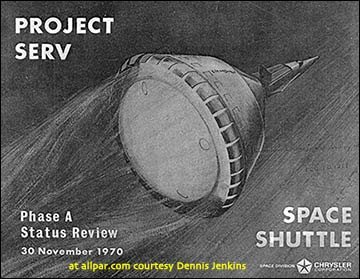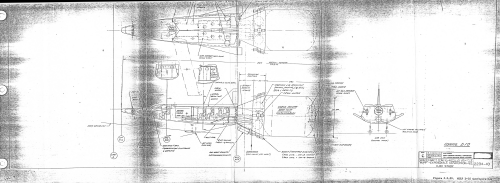From the astonautix site
http://www.astronautix.com/lvs/shuttle.htm

VTOVL orbital launch vehicle. Status: Study 1971. Manufacturer's Designation: SERV.
Chrysler ballistic single stage to orbit alternate shuttle proposal of June 1971. This was the most detailed design study ever performed on a VTOVL SSTO launch vehicle. The 2,040 tonne SERV was designed to deliver a 53 tonne payload to orbit in a capacious 7 m x 18 m payload bay.
The Chrysler SERV single-stage-to-orbit ballistic vehicle was the subject of a six-volume report produced under the $ 1.9 million NASA contract NAS8-26341. The booster could be launched from the existing LC39 built for the Saturn V. SERV would be built at NASA's Michoud facility and transported by a 'Bay'-class vessel modified to carry the wide load through the existing inland waterway system between Michoud and Cape Canaveral. SERV was a squat 27.4 m in diameter and 20.3 m tall. A payload of 52,800 kg, housed in a 7 m x 18.3 m cargo bay, could be transported to a 185 km/28.5 deg orbit. The vehicle was powered by a 12-module aerospike engine, 26.6 m in diameter and 2.5 m tall, producing 2.45 million kilograms of thrust at a specific impulse of 347 seconds at lift-off. The engine could be throttled to 80%, and the turbopumps were interlinked, so that the failure of any one pump could be compensated for by bringing the others up to 120% of their rated capacity. Protective doors covered the engine during the base-first re-entry, which would be accurate enough to bring the booster to within 6500 m of the aim point.. After slowing to subsonic speed,. 28 x 11,400 kgf turbojet engines powered by JP-4 fuel braked the spacecraft to a hover and soft touchdown on landing pads 2.8 km from the Vertical Assembly Building at the Kennedy Space Center. For manned missions, a MURP spaceplane would be used for separate return of the crew to earth. Total development costs was estimated as $3.565 billion, with each SERV costing $350 million in FY1971 dollars, and being rated for 100 flights over a 10 year service life.
As had Philip Bonob at Douglas before them, the Chrysler team, led by Charles Tharratt, fervently believed that they had the best solution to providing America with routine access to space. But NASA was wedded to the concept of a winged shuttle and never gave SERV any serious consideration.
Manufacturer: Chrysler. LEO Payload: 52,800 kg (116,400 lb). to: 185 km Orbit. at: 28.50 degrees. Liftoff Thrust: 25,795.300 kN (5,799,014 lbf). Total Mass: 2,040,816 kg (4,499,229 lb). Core Diameter: 27.40 m (89.80 ft). Total Length: 20.30 m (66.60 ft). Development Cost $: 3,565.000 million. in: 1971 average dollars. Flyaway Unit Cost $: 350.000 million. in: 1971 unit dollars.
* Stage1: 1 x Shuttle SERV-1. Gross Mass: 2,040,816 kg (4,499,229 lb). Empty Mass: 226,757 kg (499,913 lb). Motor: 1 x Plug-Nozzle SERV. Thrust (vac): 31,980.515 kN (7,189,506 lbf). Isp: 455 sec. Burn time: 249 sec. Length: 20.27 m (66.50 ft). Diameter: 18.29 m (60.00 ft). Propellants: Lox/LH2.
Was this idea workable and why did they design for 52,800kg to LEO, this is way above what NASA and the USAF were looking at?
Also some information here
http://forum.nasaspaceflight.com/index.php?topic=5771.0
http://www.astronautix.com/lvs/shuttle.htm

VTOVL orbital launch vehicle. Status: Study 1971. Manufacturer's Designation: SERV.
Chrysler ballistic single stage to orbit alternate shuttle proposal of June 1971. This was the most detailed design study ever performed on a VTOVL SSTO launch vehicle. The 2,040 tonne SERV was designed to deliver a 53 tonne payload to orbit in a capacious 7 m x 18 m payload bay.
The Chrysler SERV single-stage-to-orbit ballistic vehicle was the subject of a six-volume report produced under the $ 1.9 million NASA contract NAS8-26341. The booster could be launched from the existing LC39 built for the Saturn V. SERV would be built at NASA's Michoud facility and transported by a 'Bay'-class vessel modified to carry the wide load through the existing inland waterway system between Michoud and Cape Canaveral. SERV was a squat 27.4 m in diameter and 20.3 m tall. A payload of 52,800 kg, housed in a 7 m x 18.3 m cargo bay, could be transported to a 185 km/28.5 deg orbit. The vehicle was powered by a 12-module aerospike engine, 26.6 m in diameter and 2.5 m tall, producing 2.45 million kilograms of thrust at a specific impulse of 347 seconds at lift-off. The engine could be throttled to 80%, and the turbopumps were interlinked, so that the failure of any one pump could be compensated for by bringing the others up to 120% of their rated capacity. Protective doors covered the engine during the base-first re-entry, which would be accurate enough to bring the booster to within 6500 m of the aim point.. After slowing to subsonic speed,. 28 x 11,400 kgf turbojet engines powered by JP-4 fuel braked the spacecraft to a hover and soft touchdown on landing pads 2.8 km from the Vertical Assembly Building at the Kennedy Space Center. For manned missions, a MURP spaceplane would be used for separate return of the crew to earth. Total development costs was estimated as $3.565 billion, with each SERV costing $350 million in FY1971 dollars, and being rated for 100 flights over a 10 year service life.
As had Philip Bonob at Douglas before them, the Chrysler team, led by Charles Tharratt, fervently believed that they had the best solution to providing America with routine access to space. But NASA was wedded to the concept of a winged shuttle and never gave SERV any serious consideration.
Manufacturer: Chrysler. LEO Payload: 52,800 kg (116,400 lb). to: 185 km Orbit. at: 28.50 degrees. Liftoff Thrust: 25,795.300 kN (5,799,014 lbf). Total Mass: 2,040,816 kg (4,499,229 lb). Core Diameter: 27.40 m (89.80 ft). Total Length: 20.30 m (66.60 ft). Development Cost $: 3,565.000 million. in: 1971 average dollars. Flyaway Unit Cost $: 350.000 million. in: 1971 unit dollars.
* Stage1: 1 x Shuttle SERV-1. Gross Mass: 2,040,816 kg (4,499,229 lb). Empty Mass: 226,757 kg (499,913 lb). Motor: 1 x Plug-Nozzle SERV. Thrust (vac): 31,980.515 kN (7,189,506 lbf). Isp: 455 sec. Burn time: 249 sec. Length: 20.27 m (66.50 ft). Diameter: 18.29 m (60.00 ft). Propellants: Lox/LH2.
Was this idea workable and why did they design for 52,800kg to LEO, this is way above what NASA and the USAF were looking at?
Also some information here
http://forum.nasaspaceflight.com/index.php?topic=5771.0




